
Station Name: CRAVEN ARMS
|
| Date opened: | 21.4.1852 |
| Location: | West side of Station Crescent |
| Company on opening: | Shrewsbury and Hereford Railway |
| Date closed to passengers: | Still open |
| Date closed completely: | Still open |
| Company on closing: | Still open |
| Present state: | The bay platform is extant but stout fencing has been installed along the platform edge. The goods shed to the north of the station survives and is now used as a farm shop. |
| County: | Shropshire |
| OS Grid Ref: | SO432830 |
| Date of visit: | September 2009 |
Notes: The station serves the small town of Craven Arms. Although initially called Craven Arms this was changed to Craven Arms & Stokesay in July 1879, named after the nearby coaching inn (the settlement developed only after the arrival of the railways) and the historic settlement of Stokesay to the south. The station reverted to its original name on 6 May 1974.
As built the station had two facing and partly staggered platforms, with a bay platform at the north end of the down (west) platform. This was initially used by trains from Bishop's Castle but was also used by Much Wenlock trains when that line opened in 1867. Trains arriving from Bishop's Castle would arrive at the main line down platform where passengers disembarked. The train would then move to the bay platform and await departure back to Bishop's Castle.
After closure of the Bishop's Caste line the large station running-in boards displayed the wording 'Craven Arms & Stokesay - Junction for Central Wales Route to Llandrindod Wells, Brecon, Llanelly, Swansea, Carmarthen, Tenby, Pembroke Dock etc'. The later, slightly less wordy BR running-in boards were removed before 1973 when the station name was shortened to Craven Arms and the new corporate identity signs arrived. By this time, all the station buildings had been demolished to be replaced with two small ‘bus shelters’ made of concrete blocks; only the covered footbridge remained. The two shelters and footbridge were, in turn, replaced in the 1980s. The new shelters were brick-built with all-round canopies and saw-tooth valances, more pleasing to the eye than the utilitarian concrete shelters they replaced.
The Craven Arms carriage sheds lay derelict for many years when, in 2003, Network Rail arranged to have them demolished on safety grounds. The historical significance of the sheds to the town, born out of the railways, was clear, and the Craven Arms Carriage Sheds Regeneration Association was established by members of the community to save them. It successfully negotiated a ‘stay of execution’ with Network Rail and set about attracting funding. A business plan and forward strategy was produced which listed three options: a railway heritage location; workshops and industrial space; or do nothing. The business plan revealed that, although a mix of both A and B would be sustainable once trading began, the initial capital cost of renovation could have exceeded £6,000,000. Funding bodies would not consider this level of support within the time frame dictated by Network Rail, and the sheds were demolished in March 2004. Although the Bishop's Castle and the Much Wenlock lines have closed, Craven Arms is still a junction where the ‘Heart of Wales’ route branches from the ‘Welsh Marches’ line. All passenger trains calling at the station are now operated by Arriva Trains Wales, who also manage it. Platform 1, on the west side, serves northbound trains to Shrewsbury and beyond as well as trains both to and from Swansea via the ‘Heart of Wales’. Platform 2, on the town side of the station, serves southbound trains to Hereford and Cardiff. With the closure of the goods yard the station signal box was closed and demolished, but the second box by Long Lane level crossing is still in use. BRIEF HISTORY OF THE BISHOP'S CASTLE RAILWAY
a later date.
Further surveys were completed early in 1862, and the company started to purchase land prior to construction. Oswestry-based contractor Thomas Savin was hired to build the railway; in his career Savin built at least ten different railways in Wales and the border area. Having taken an advance payment of £20,500, construction started in March 1863 but ground to a halt almost immediately as Savin was in financial difficulties. This was a gloomy portent of what was to come, and the company was forced to pursue its contractor into Chancery in the summer of 1864. Thomas Savin eventually declared himself bankrupt in February 1866.
second Act, The Bishop’s Castle Railway (Deviations) Act, was obtained in 1865. This authorised a further branch from Chirbury on the BCR to Minsterley which would give more direct access to Shrewsbury.
By October 1865 the 9½-mile section from Stretford Bridge, where the line made a junction with the S & H a little north of Craven Arms, to Lydham Heath and the ‘branch’ to Bishop’s Castle itself was complete. The planned triangular junction at Lydham Heath had not been built (and never was due to lack of funds) and there was only a north-facing junction which meant that all trains stopped at Lydham Heath, where the locomotive had to run round the train before completing its journey to Bishop’s Castle.
Despite these awkward junction arrangements the company decided to open the line to passenger traffic immediately, before Bishop's Castle station had even been built, and without waiting for the Board of Trade inspection - which was a legal requirement. The formal opening was on Tuesday 24 October 1865, when a large crowd gathered at Bishop's Castle to see a locomotive and 11 coaches, probably borrowed from the Mid-Wales Railway for the occasion, and laden with shareholders.
unclear if these stations actually opened with the line. A further station at Stretford Bridge, close to the junction with the Shrewsbury & Hereford (LNWR & GWR Joint from 1870) opened in 1890. There were four trains a day in each direction with the fastest journey time of 30 minutes. Some trains, however, took up to 50 minutes, running at an average speed of 12 mph!
London with debts totalling £11m. Many small railway companies with lines under construction were badly hit, including the Bishop’s Castle. The two extensions to Montgomery and Minsterley were scrapped, but this was not sufficient to save the line which was now close to bankruptcy.
By the end of the first year the infant railway was bankrupt. From that time the company’s long life under the receiver began. Not for the last time bailiffs descended on the line and, while the train service was allowed to continue under supervision, most of the assets were seized and offered for sale by auction at the George Hotel in Shrewsbury on 23 January 1867. The total sum realised by the 61 lots was £3,522, the Midland Waggon Company, being the principal purchaser. Although the creditors were paid, the Bishop's Castle Railway remained in permanent receivership.
The total sum realised by the 61 lots was £3,522; the Midland Waggon Company, being the principal purchaser. Although the creditors were paid, the Bishop's Castle Railway remained in permanent receivership. Despite its shaky start, the Midland Waggon Co. and the debenture shareholders were convinced of the line's potential and were content for it to continue to operate under the receiver. Following the auction the rolling stock was immediately leased back to the BCR.
having been obtained the matter was placed in the hands of a Sheriff who, however, could find no further property to seize. The Bishop’s Castle receiver was curiously impervious to any demands for money, it would seem, and the line continued to operate strangely immune to judgment or regulation.
convenience and the loss to him of a few acres of land was of little consequence. After Beddoes death, his wife took a different view and pressed for the money, eventually taking the company to court for the £800 that had never been paid. She won her case and, when the outstanding debt was not settled by the BCR, bailiffs were called in.
on them for their cold and lonely job. The visitors suggested a drink at the village pub, the Lion Inn, and the bailiffs readily agreed believing there was no chance of anyone trying to reinstate the line at that time of night. A gallon or two of mulled beer, tempered with a drop of gin, was served in front of the blazing fire. This seemed to suit the bailiffs better than keeping watch on a cold night. In the meantime a gang of men had placed the rails back in position and, soon after, an engine with all the empties crept quietly down from Bishop’s Castle into Craven Arms, picked up a train load of goods and coal, and steamed off at full speed towards the beleaguered town. By this time the bailiffs had recovered a little, in fact, sufficiently so to hear the engine. They ran out of ‘The Lion' shouting and trying in vain to stop the train as it sped by. They had been outwitted, and the goods and coal were safely unloaded at Bishop’s Castle. The lawyers threatened the manager with arrest, but he was able to prove an alibi.
After this incident the Bishop’s Castle Railway was allowed to continue to operate although the first mutterings against the management of the receiver were beginning to be heard. A takeover by the GWR was suggested together with the revival of the original aims to open through to Montgomery. The problem of the Beddoes’ land was solved through a rental arrangement, and another `celebratory (re)opening’ took place on 2 July 1877. Further threats to the railway arrived at frequent intervals. It was peculiarly vulnerable, of course, through its odd legal position; inheritors of the shares and interest and debts incurred from the 1860s did not look on the line as compassionately as their fathers. Court cases, and the threat of them, were ever present.
purchase of the Bishop’s Castle, was being actively discussed by the MP in London, though a more attractive alternative had surfaced. Suggested by the Reverend Prebendary White, vicar of Church Stoke, this envisaged a continuation from Lydham to Montgomery but via Kerry and Newtown.
On 13 March 1903 it was revealed that all litigation was at last at an end, and the Bishop’s Castle Railway, now free of legal entanglement, was already the object of a ‘syndicate sitting in London'. It would purchase the line and extend it either to Montgomery, to Welshpool or to Newtown (via Kerry). Great things were predicted. However Jasper More died at the end of November 1903, and this signalled an end to much of the active campaigning for extension of the line; his indefatigable effort to promote the prosperity of the district was also at an end.
but this came to nothing although talk of the extension staggered on through the early 1920s; the Great Western sensibly fended off a recommendation by the Council that it should take an interest in the ‘direct Montgomery’ route. By this time the service had been reduced to three trains a day in each direction.
The Bishop’s Castle Railway was still bankrupt and unwanted and as such would probably have 'gummed up the works' of the Grouping Bill. It therefore remained independent at the establishment of the 'Big Four' in 1923. The Grouping seemed to render the Bishop’s Castle even more of an anachronism long before the next closure crisis, in 1930/31.
In the House of Commons the new Ludlow MP, Col. Windsor Clive, asked the Minister of Transport, Herbert Morrison, if he proposed to take any action on a resolution of Bishop’s Castle Borough Council that the Great Western should take over the line. Having already consulted with the GWR, Morrison stated that upon ‘careful consideration’ he did not propose to promote legislation for the compulsory transfer of the railway.
disbanded although
The Defence Trust was still in existence, presiding over dwindling funds.
By now, the closure threat had become perennial, and all suggestions of extensions to Montgomery or elsewhere had been forgotten. In May 1933 the council expressed ‘the profoundest apprehension and dismay’ at the latest threatened closure stating it would raise the price of all the necessities of life, inevitably cause further unemployment, handicap farming locally, possibly kill off altogether the local cattle market and bring further rural depopulation. Through all the threats and upsets, closure was stalking the line throughout its life, but there was always hope - almost an assumption - that somehow things would work out. From the early 1930s this changed, and a feeling of inevitable finality, a resignation to closure, took hold.
but withdraw the receiver. This they duly did on 8 April, to be later confirmed by the Master of Chancery. The end for both passenger and freight traffic was fixed for Saturday 20 April 1935. Rural bus services had started in 1900, and it was road transport that eventually dealt the railway its death blow.
The final demolition train left the line at Stretford Bridge Junction on 21 February 1937. Most of the rails went as scrap metal to Birkenhead where they were used by the Cammell Laird shipyard in the construction of HMS Prince of Wales. So effectively a piece of the Bishop's Castle Railway lies to this day on the bed of the South China Sea! The easternmost stretch of line has been incorporated into the Onny Trail, forming a walk along the banks of the River Onny and across the fields where passengers stepped down to pick mushrooms. The course of the line is clearly visible today, well demarcated and forms a broad grassy walkway through sheep pasture or woodland trackway.
Castle. Opening times are: Saturday and Sundays 14.00 hrs – 17.00 hrs from Easter to the end of September.
Tickets from Michael Stewart. except 383 Brian Halford. Bradshaw Chris Hind , GWR timetable from Chris Totty. Route maps drawn by Alan Young. Sources:
Further reading and other web sites:
|
arms_old2.jpg)

arms_old1.jpg)
Copyright photo from John Alsop collection
arms_old11.jpg)
Photo from John Mann collection
arms_old3.jpg)
arms_old4.jpg)
arms_old5.jpg)
arms_old6.jpg)
arms1.jpg)
Photo by John Mann
arms10.jpg)
Photo from John Mann collection
arms11.jpg)
arms18.jpg)
Photo by Roy Lambeth
| Last updated: Wednesday, 17-May-2017 09:22:27 CEST |
© 1998-2012 Disused Stations
|
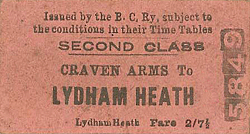
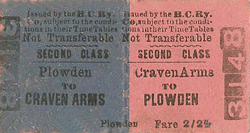

28.gif)
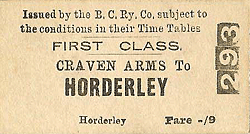
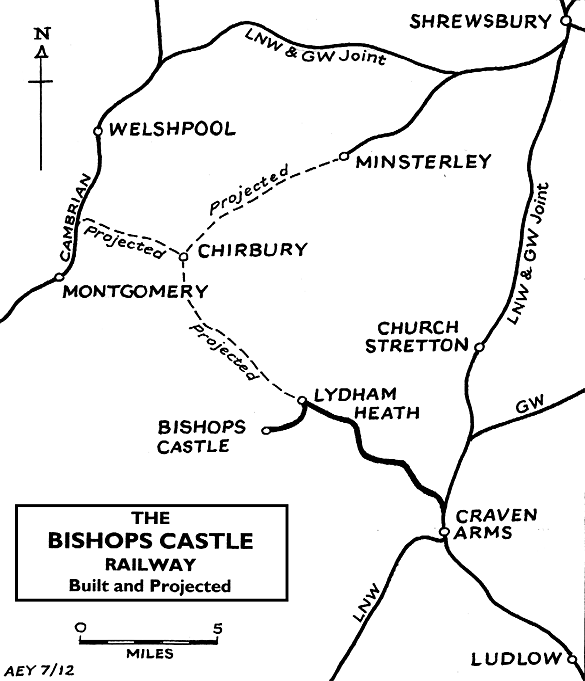




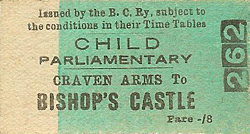

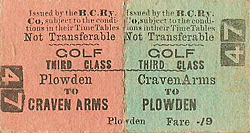

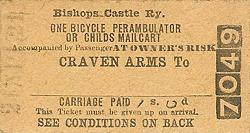


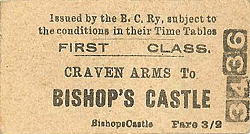
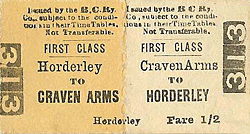
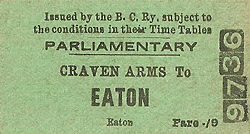
arms_old9.jpg)
arms24.jpg)

 Home Page
Home Page